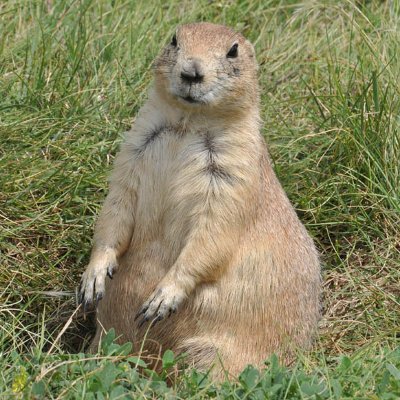Prairie Dog
Category: North American Mammals

Facts about Prairie Dog, "Scientific name about Prairie Dog is Cynomys ludovicianus". The Prairie Dog is a Cynomys type of burrowing rodents that comes from the Marmotini family. The Prairie Dogs hail from the plains of North America, and they come in five dissimilar species, such as black-tailed, Gunnison's, white-tailed, Mexican and Utah dogs. The Prairie Dog are a category of land squirrel, which are largely found in Mexico, Canada and in the United States of America. In Mexico, the Prairie Dogs are chiefly found in the northern states, which are located at the southern extreme of the Great Plains, such as north and northeastern part of Chihuahua, northeastern Sonora, northern parts of Nuevo León, and northern parts of Tamaulipas. In the United States, the Prairie Dog range chiefly in the western part of the Mississippi River, though they have can also be seen in some eastern settings.
Features of Prairie Dog
The Prairie Dog is a keystone variety of animals that attains a maximum body length, ranging from 12 inches to 15 inches (30.4 to 38.1 cm), with the small tail, ranging from 2 inches (5.08 centimeters)to 3 inches (7.62 centimeters) in length. The Prairie Dogs have a body mass that ranges from 1 pound (0.453 kg) to 3 pounds (1.360 kg).
Prairie dogs area food resource for several animals, as well as eagles, coyotes, badgers and dangerously endangered black-color footed ferrets. Several varieties, such as tiger salamanders and black-footed ferrets, exploit their holes as homes. Prairie dogs help to ventilate and fertilize the soil, enabling a larger variety of plants to flourish.
Prairie dogs are colonial creatures that inhabit multifaceted networks of tunnels with numerous openings. The Prairie Dog colonies can be effortlessly identified by the raised-hole entrances that provide the extremely small prairie dogs some additional height when functioning as sentries and observing the signals of hazard. The channels include separate rooms for rearing the young, sleeping, storing the food and removing waste.
Diet of Prairie Dog
Prairie dogs are herbivores, and they mostly feed on grasses, flowering plants, sedges, seeds and roots. Occasionally, the Prairie Dog feed on insects, too. They uses their front paw for eating similar to how humans use their hands.
Behavior of Prairie Dog
Prairie dogs are extremely social and inhabit closely-knit relatives groups known as coteries. Usually, coteries include an adult male Prairie Dog, one or more adult female dogs and their juvenile offspring. These coteries are combined together into neighborhoods or wards, and numerous wards structure a settlement or town. The Prairie Dog have a difficult system of communication that comprises a range of pitched caution barks that signal dissimilar kind of predators. The Prairie Dogs attained their name from colonists roaming across the plains who considered that these caution calls sounded like the barking of dogs.
Reproduction of Prairie Dog
Prairie dogs are inclined to be sexually dimorphic. Sexual dimorphism is maximum at the time of weaning, while the female Prairie Dogs start losing their weight and the male dogs start consuming additional food, and is at its least when the female Prairie Dogs are pregnant, which is as well while the male Prairie Dogs are tired from reproduction. Reproduction in Prairie dogs commences during the month of March, and the gestation period normally takes 33 to 38 days. The female Prairie Dog gives birth to pups during April or May. The litter size ranges from 1 to 8 pups.
The average lifespan of the Prairie Dog ranges from 8 years to 10 years.

 Back To Category North American Mammals
Back To Category North American Mammals